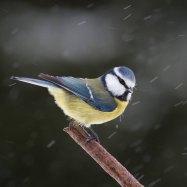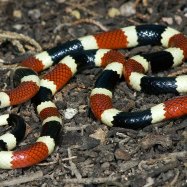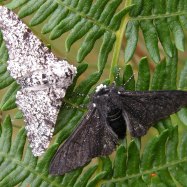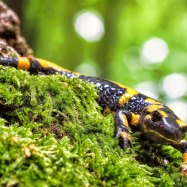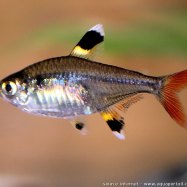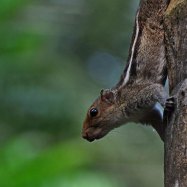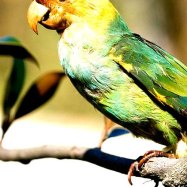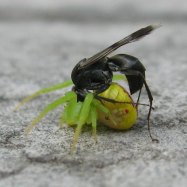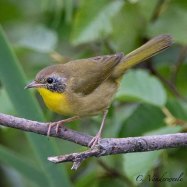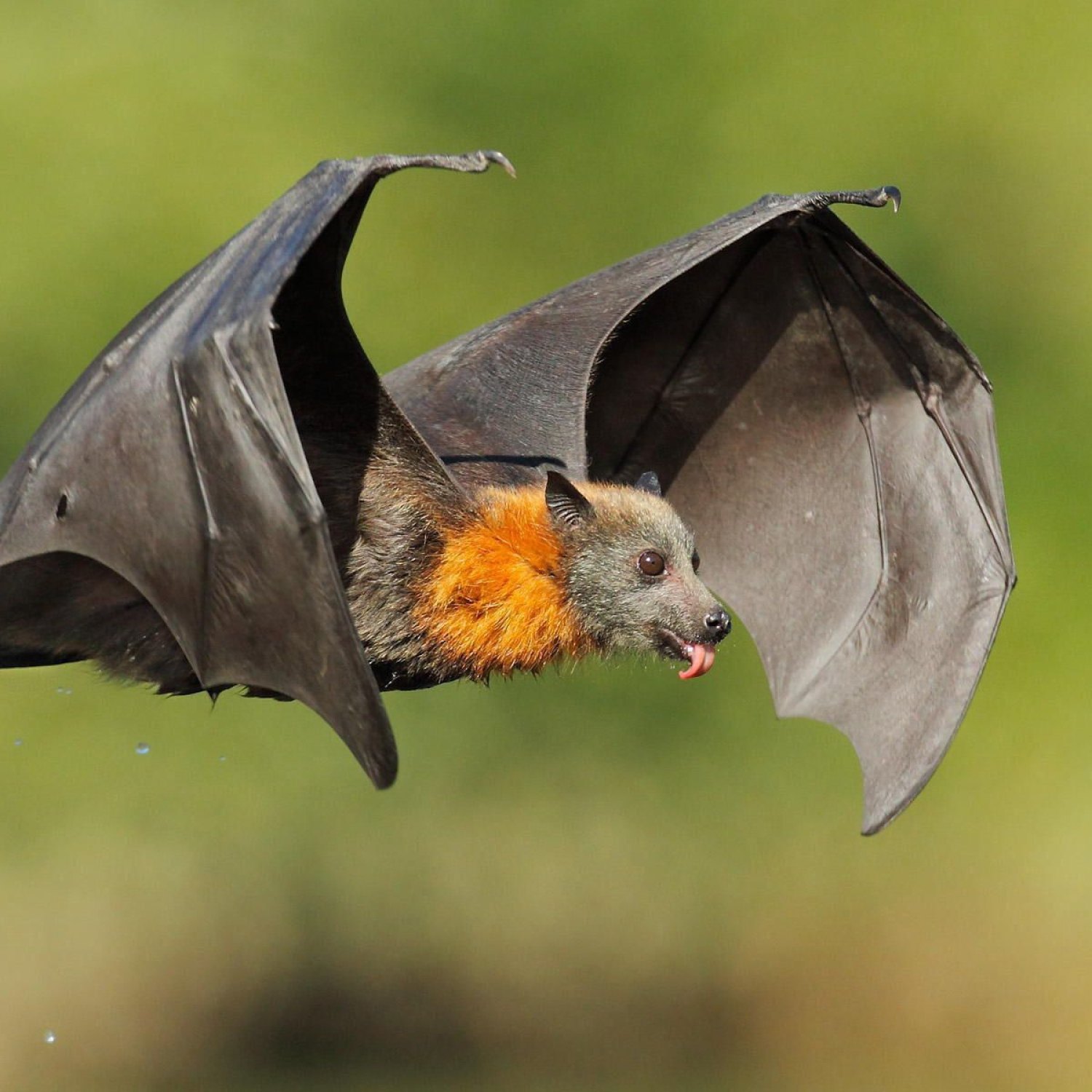
Bat
2.3 to 7.1 inches (6 to 18 cm)
Bats, a diverse group of flying mammals, can be found in various locations worldwide. Ranging from 2.3 to 7.1 inches in length, they come in different body shapes due to belonging to multiple families. Fascinating creatures indeed! #Bats #Mammals #Nature
Animal Details Summary:
Common Name: Bat
Kingdom: Animalia
Habitat: Various habitats including forests, deserts, caves
The Fascinating World of Bats: Mammals of the Night Skies
When we think of mammals, we often envision furry creatures such as cats, dogs, or monkeys. However, there is a group of mammals that are truly unique and fascinating - bats. These winged creatures with their nocturnal lifestyle and secretive habits have captured the imaginations of humans for centuries.Bats belong to the Order Chiroptera, from the Greek words "cheir" meaning hand and "ptera" meaning wings Bat. With their unique ability to fly, they have evolved and adapted to various habitats around the world. They are the only mammals capable of true flight, making them truly extraordinary animals.
In this article, we will delve into the world of bats, exploring their biology, behavior, and their vital role in our ecosystems.
The Taxonomy of Bats
Bats belong to the Kingdom Animalia, Phylum Chordata, and Class Mammalia, making them a diverse group of mammals that share many characteristics with other mammals. However, within the Class Mammalia, bats have been classified into their own Order - Chiroptera, which consists of two suborders, Megachiroptera and Microchiroptera.Megachiroptera, also known as the fruit bats or flying foxes, are primarily found in tropical regions and have a diet that consists mainly of fruits and nectar. They have a larger body size and are typically diurnal, meaning they are active during the day.
On the other hand, Microchiroptera, also known as echolocating bats, are found all over the world, and their diet includes insects, fruits, and even small animals. They have a smaller body size and are mostly nocturnal, relying on their exceptional echolocation abilities to navigate and hunt for food in the dark Badger.
Within these two suborders, there are approximately 1,400 species of bats, making up 20% of all known mammal species. This vast number signifies the incredible diversity and success of these creatures.
A Habitat for Every Bat
From the lush rainforests of the tropics to the dry deserts of the Middle East, bats have adapted to various habitats around the world. They are found on every continent except Antarctica, with the majority of species residing in the tropics.Bats are highly adaptable animals and can be found in a wide range of habitats, including forests, deserts, grasslands, and even urban areas. Their preferred roosting sites can be anything from caves, tree hollows, abandoned buildings, and even underground mines.
Their ability to thrive in various environments is due to their unique features, such as their wings and their echolocation abilities, which enable them to fly, forage for food and navigate in the dark.
The Many Faces of Bats
While we may often picture bats as Small, dark creatures with sharp teeth, the truth is they come in many shapes, sizes, and colors. With over 1,400 species, bats exhibit a remarkable range of physical characteristics, allowing them to thrive in their respective habitats.The smallest bat species, the bumblebee bat, can fit on a person's fingertip and weighs less than a penny. On the other hand, the largest bat species, the flying fox, has a wingspan of up to 6 feet and can weigh up to 3 pounds. This vast difference in size is a testament to the adaptability and versatility of bats.
Bats also come in a variety of colors, ranging from brown, black, gray, white, and even bright hues of red, orange, and yellow. Their fur or skin color is often dependent on their natural habitat, with some species exhibiting patterns and markings to help them camouflage and blend in with their surroundings.
Relying on Diverse Diets
One of the most interesting facts about bats is their diverse diet. While many people associate bats with bloodsucking, the truth is that only three species out of more than 1,400 feed on blood, and they do so exclusively in Latin America.The majority of bats are insectivorous, preying on insects such as moths, beetles, and mosquitoes. Insect-eating bats can consume over 1,000 insects in just one night, making them a highly valuable asset in controlling insect populations.
Some bats have even evolved to become frugivorous, feeding on fruits and nectar. They play a significant role in pollination and seed dispersal, making them critical contributors to the health of ecosystems.
Carnivorous bats are also present in some species, preying on small vertebrates such as frogs, lizards, and even other bats. These bats have sharp, pointed teeth and powerful jaws, allowing them to hunt and consume their prey efficiently.
Bats and Echolocation
One of the most remarkable features of bats is their echolocation abilities. Bats use sound waves to navigate and find food in the dark, making them one of the few animals capable of true sonar.Bats produce high-frequency sounds, beyond the range of human hearing, which bounces off objects, allowing them to create an auditory map of their surroundings. With this ability, bats can detect even the smallest insects and obstacles in their path, ensuring safe and efficient flight.
Echolocation is crucial for bats, particularly those that are nocturnal, as it allows them to hunt, communicate, and navigate in the dark without the use of sight.
A Vital Role in Ecosystems
Bats may have a reputation as mysterious and sometimes scary creatures, but they play a critical role in our ecosystems. As pollinators, seed dispersers, and pest controllers, bats contribute to the health and balance of many ecosystems.Without bats, insect populations would skyrocket, leading to crop damage and spread of diseases. Some species of bats are also vital pollinators for plants such as bananas, mangoes, and agave, which are important food sources for humans.
As seed dispersers, bats help to maintain the diversity of plant species in their environments, contributing to the overall health and stability of ecosystems.
Threats to Bat Populations
Despite their immense value and contribution to our ecosystems, bat populations are facing significant threats. Human activities, such as habitat destruction, use of pesticides, and disturbance of roosting sites, are some of the factors contributing to the decline of bat populations.The introduction of invasive species and diseases, like White-Nose Syndrome, is also a grave threat to many bat species. Climate change also poses a risk to bats, as it affects their distribution, food availability, and other vital factors for their survival.
It is essential to understand and mitigate these threats to ensure the survival of bat populations, which are crucial to our ecosystems and the well-being of our planet.
Respecting and Protecting Bats
As our understanding of bats grows, so does our appreciation for these marvelous creatures. With their unique adaptations, diverse diets, and vital role in ecosystems, it is clear that bats are an integral part of our world.As individuals, we can take simple steps to protect bats and their habitats, such as avoiding the use of pesticides, educating others about the benefits of bats, and supporting conservation efforts.
By respecting and protecting bats, we can help ensure a future where these incredible animals continue to thrive and contribute to the health and balance of our planet.
Conclusion
Bats may often be portrayed as scary or mysterious, but the truth is they are marvelous and essential creatures. From their unique adaptations to their vital role in ecosystems, bats have captured the hearts and imaginations of humans for centuries.As we continue to learn and appreciate these fascinating creatures, it is crucial to protect and conserve their populations. By respecting and protecting bats, we can ensure a world where they continue to fill our skies, contributing to the beauty and balance of nature.

Bat
Animal Details Bat - Scientific Name: Chiroptera
- Category: Animals B
- Scientific Name: Chiroptera
- Common Name: Bat
- Kingdom: Animalia
- Phylum: Chordata
- Class: Mammalia
- Order: Chiroptera
- Family: Multiple families
- Habitat: Various habitats including forests, deserts, caves
- Feeding Method: Insectivorous, frugivorous, carnivorous
- Geographical Distribution: Worldwide
- Country of Origin: Various countries
- Location: Various locations
- Animal Coloration: Varies depending on species
- Body Shape: Varies depending on species
- Length: 2.3 to 7.1 inches (6 to 18 cm)
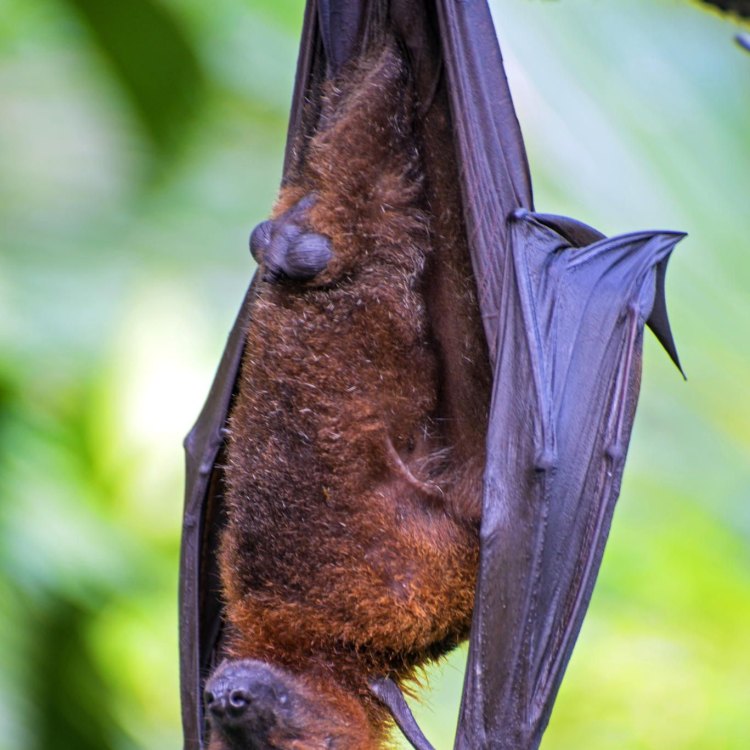
Bat
- Adult Size: Varies depending on species
- Average Lifespan: Up to 30 years
- Reproduction: Sexual
- Reproductive Behavior: Varies depending on species
- Sound or Call: Varies depending on species
- Migration Pattern: Varies depending on species
- Social Groups: Varies depending on species
- Behavior: Nocturnal
- Threats: Habitat loss, hunting
- Conservation Status: Varies depending on species
- Impact on Ecosystem: Pollination, insect control
- Human Use: Source of guano, pest control
- Distinctive Features: Wings, echolocation
- Interesting Facts: Only mammal capable of sustained flight, diverse group with over 1,400 species
- Predator: Birds of prey, snakes, mammals
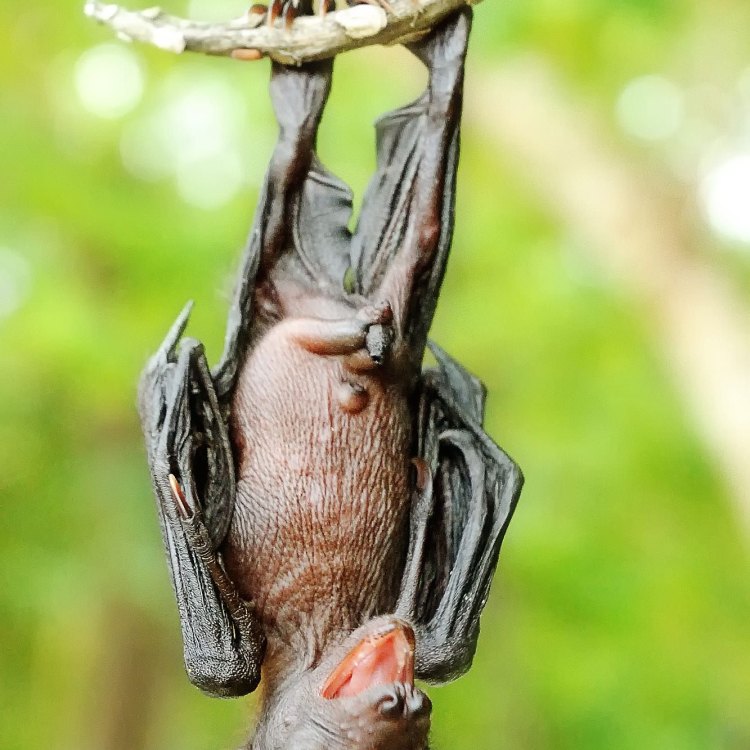
Chiroptera
Unleashing the Secrets of Bats: Flying Mammals that Rule the Night
When we think of flying creatures, birds and insects may immediately come to mind. However, there is one group of animals that often gets overlooked in the aerial world – bats. These intriguing and sometimes misunderstood creatures possess a unique set of features and behaviors that have allowed them to conquer the skies and thrive in diverse habitats all over the world.Bats are a diverse group of mammals with over 1,400 known species, making them one of the largest mammalian orders PeaceOfAnimals.Com. They can be found in almost every part of the world, except for the polar regions and some small islands. Although they may vary in size, behavior, and appearance, all bats share one impressive characteristic – they are the only mammals capable of sustained flight.
Let's take a closer look at these fascinating creatures and discover what makes them truly unique in the animal kingdom.
The Basics: Size, Lifespan, and Reproduction
Bats come in a variety of sizes, ranging from the bumblebee bat, the smallest mammal in the world that can fit on a human fingertip, to the giant golden-crowned flying fox with a wingspan of over 5 feet. The size of adult bats can vary depending on the species, with some being as small as 3 inches and others as large as 6 feet. Similarly, their lifespans can also vary greatly, with some species living up to 30 years in the wild.Reproduction in bats is primarily sexual, meaning that they need both a male and a female to reproduce. However, their reproductive behavior can vary among species. Some bats have a monogamous mating system, where one male mates with one female, while others have a polygynous system, where one male mates with multiple females Bagle Basset Hound Mix. Female bats typically give birth to one pup per year, and they often exhibit a high level of parental care.
Echolocation: Flying with Precision
One of the most distinguishing features of bats is their ability to navigate and hunt using echolocation. This is the process of emitting high-frequency sounds, beyond the range of human hearing, and then interpreting the returning echoes to locate and identify objects in their environment. This allows bats to fly and maneuver with incredible precision, even in the dark of night.Echolocation is essential for bats, as they are primarily nocturnal creatures. They have adapted to hunt and forage for food at night and have developed a keen sense of hearing and echolocation to help them locate their prey – mostly insects. Some larger species of bats can also hunt larger prey like frogs, lizards, and fish.
Bat Sounds and Calls: A Language of Their Own
Just like humans, bats also use sounds to communicate with each other. However, their calls and vocalizations can vary depending on the species. Some bats produce calls that are audible to the human ear, while others use ultrasonic calls that can only be heard through specialized equipment. These calls can serve different purposes, including communicating with other bats, locating food, or even warning other bats of potential danger.For example, the greater sac-winged bat produces calls to attract mates, whereas the greater horseshoe bat uses calls to defend their territory. Some bats have also been observed sharing information with fellow bats about food availability and the location of roosts.
Migratory Patterns and Social Groups
As a diverse group, bats exhibit a wide range of migratory patterns and social behaviors. Some species are solitary and prefer to roost alone, while others may live in large social groups. Some bats may also migrate to warmer climates during the winter, while others may choose to hibernate in their roosts.In terms of social structures, bats can form groups based on reproductive behavior, age, or even gender. For example, female bats may form maternity colonies during the breeding season, while male bats may form bachelor colonies. These social structures allow them to protect and support each other, making them stronger and more resilient as a group.
The Threats to Bats: Habitat Loss and Hunting
Unfortunately, bats face many threats that have led to a decline in their populations. Habitat loss is one of the most significant threats to bats, as deforestation and urbanization reduce the availability of suitable roosting sites and foraging areas. Climate change has also affected bat populations, causing shifts in their range and disrupting their reproductive cycles.In addition to habitat loss, bats are also threatened by human activities such as hunting and culling. In some cultures, bats are considered a delicacy and are hunted for their meat, while in other areas, bats are seen as pests and are killed in large numbers to protect crops and livestock.
Conservation Status: The Need for Protection
Due to their declining populations, many species of bats are considered vulnerable, endangered, or critically endangered. The conservation status of bats can vary depending on the species and their specific threats. For example, the gray-headed flying fox is listed as vulnerable due to habitat destruction and human disturbance, while the Mexican long-nosed bat is listed as endangered due to habitat loss and mortality from human-made structures.Efforts are being made to protect and conserve bat populations by creating and preserving suitable habitats and implementing laws to protect them from hunting and culling. Research is also ongoing to better understand the behavior and needs of different bat species, which can aid in creating effective conservation strategies.
The Impact of Bats on Ecosystems
Bats may often be associated with spooky stories and Halloween decor, but their role in ecosystems is far from scary. As insectivorous mammals, bats play a vital role in insect control, helping to keep pest populations in check. In some areas, bats can consume thousands of insects in a single night, making them incredibly efficient at pest control.Bats also play a crucial role in pollination and seed dispersal. Some species of fruit bats are important pollinators for many plants, including mangoes, bananas, and agave, which are responsible for producing tequila. Bats also aid in pollination by feeding on the nectar and pollen of flowers and then transferring them to other plants as they fly.
Moreover, the guano (bat droppings) produced by large colonies of bats is a valuable resource for agriculture, acting as a natural fertilizer. This not only benefits crops but also helps maintain healthy soil and diverse plant life.
Human Use of Bats: From Pest Control to Guano Collection
Throughout history, humans have found various uses for bats. In some cultures, bats have been used for medicinal purposes, believed to cure ailments such as asthma and arthritis. Others have used bat guano as a fertilizer, especially in areas where there are large bat colonies.Moreover, bats have also been used for pest control in some agricultural areas. By providing artificial roosts for bats, farmers can attract these beneficial creatures to their fields, reducing the need for harmful pesticides.
The Distinctive Features of Bats
Despite their small size, bats possess some remarkable features that have allowed them to thrive and survive in diverse environments. One of their most distinctive features is their wings, which are adapted from their front limbs. These wings are made up of a thin membrane of skin stretched between their fingers, which allows them to fly and maneuver with agility.Another unique feature of bats is their echolocation ability, which allows them to fly and hunt in the dark. Bats also have sharp claws and powerful hind limbs, which they use to cling to surfaces and forage for food.
The Circle of Life: Bat Predators and Prey
As with any animal, bats also have their fair share of predators and prey. Some of the most common predators of bats include birds of prey such as owls, hawks, and falcons. Snakes and mammals, including other bats, also prey on bat species.On the other hand, bats themselves are important prey for many predators, such as snakes, raccoons, and even some birds. Insects, on the other hand, are the main food source for most bats, with some species feeding on fruits and nectar.
The Fascinating World of Bats: A Boon to the Skies
Bats may not be the most popular or loved creatures, but they play a crucial role in the ecosystem and our world. As the only mammals capable of sustained flight, bats have proven to be adaptable and resilient creatures, able to thrive in diverse habitats all over the world.However, with their populations declining due to various threats, it is important for us to educate ourselves about these fascinating creatures and work towards their conservation and protection. By doing so, we can ensure that bats continue to enrich our lives and the world around us.
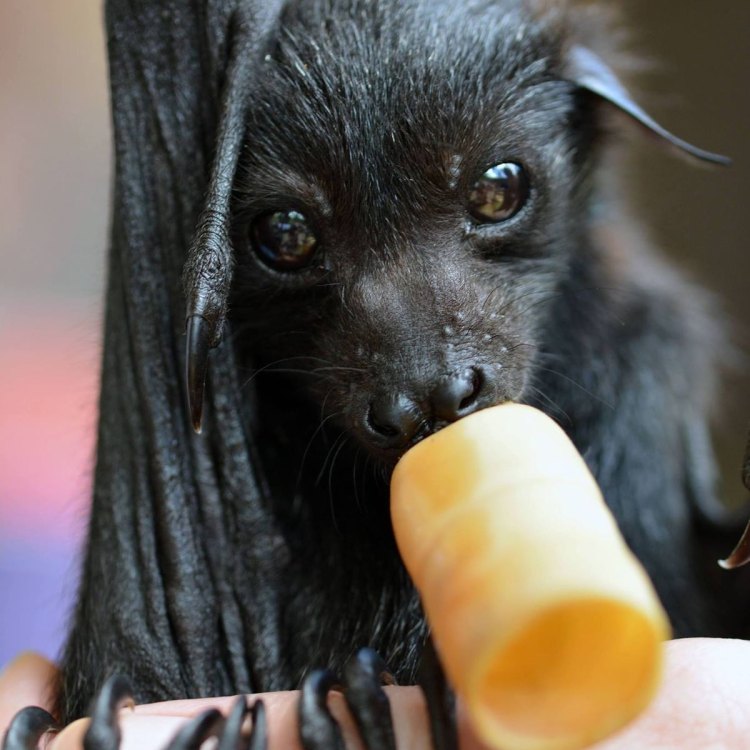
The Fascinating World of Bats: Mammals of the Night Skies
Disclaimer: The content provided is for informational purposes only. We cannot guarantee the accuracy of the information on this page 100%. All information provided here may change without prior notice.

